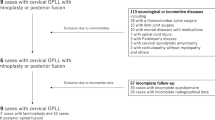Abstract
This study analyzed the postoperative results of surgical treatment for thoracic and cervico-thoracic myelopathy caused by ossification of the posterior longitudinal ligaments (OPLL) or ossification of the yellow ligaments (OYL) in 22 patients using magnetic resonance imaging (MRI), myelography and computed tomography (CT).Anterior procedures were performed in 11 patients for OPLL, while posterior approaches were adopted for the management of 11 patients for both OYL and OPLL combined with OYL lesions. Clinical symptoms were improved using both anterior and posterior techniques.MRI and myelo-CT studies, which show the direction of cord compression, the form and extent of the lesion, and the degree of thoracic kyphosis, are very useful when the surgical procedure for OPLL and OYL in the thoracic and cervico-thoracic spine is selected.
Similar content being viewed by others
Article PDF
Author information
Authors and Affiliations
Rights and permissions
About this article
Cite this article
Ido, K., Shimizu, K., Iida, H. et al. Surgical treatment for ossification of the posterior longitudinal ligament and the yellow ligament in the thoracic and cervico-thoracic spine. Spinal Cord 36, 561–566 (1998). https://doi.org/10.1038/sj.sc.3100612
Published:
Issue Date:
DOI: https://doi.org/10.1038/sj.sc.3100612
Keywords
This article is cited by
-
A systematic review of complications in thoracic spine surgery for ossification of the posterior longitudinal ligament
European Spine Journal (2017)
-
Two-staged decompression for thoracic paraparesis due to the combined ossification of the posterior longitudinal ligament and the ligamentum flavum: a case report
Archives of Orthopaedic and Trauma Surgery (2008)



